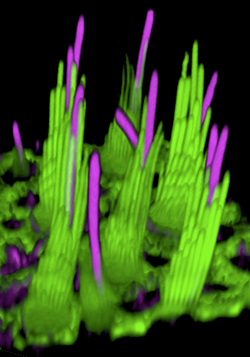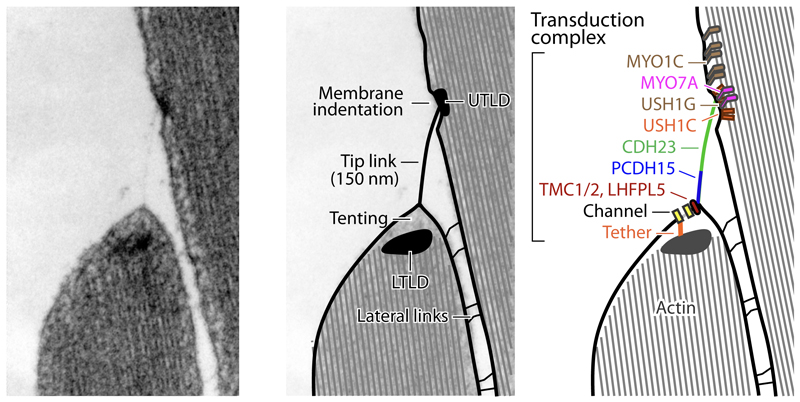About our lab
The Barr-Gillespie Lab studies mechanoelectrical transduction by hair cells, sensory cells of the inner ear.

Hair-cell transduction is carried out by the hair bundle, a cluster of actin-rich stereocilia (green in image on left) and a single microtubule-based kinocilium (magenta). Bundles are polarized, so transduction is activated when the bundle is moved towards the tallest stereocilia. We are particularly interested in the molecules that are used to construct the hair bundle and those that compose the transduction apparatus. While our approach is highly interdisciplinary, we have pioneered the use of mass spectrometry to detect and measure hair bundle proteins. Visit our Projects page to find out more about ongoing research in the lab.
Employment opportunities
Postdoctoral Fellows or Senior Research Associates
The Barr-Gillespie laboratory occasionally has positions for postdoctoral fellows or senior research associates. A background in cell biology, neuroscience, physiology, or biochemistry is ideal. If interested, please send a short description of your research background to Peter Barr-Gillespie via email; also include your CV.
Graduate Students
Graduate students can enter the Barr-Gillespie lab via the Neuroscience Graduate Program or the Graduate Program in Biomedical Sciences.
The Hearing Restoration Project
Peter Barr-Gillespie is the Scientific Director of the Hearing Restoration Project (HRP), which seeks to develop strategies for restoration of damaged hair cells in humans. The HRP, a privately-funded consortium of 15 scientists from throughout the world, works collaboratively to provide a practical understanding of hair-cell regeneration, which will enable development of therapies for hearing restoration. Our consortium has identified major roadblocks that have stymied the field, and has designed rational approaches to overcome these barriers. We will then identify targets for drug-based restoration of hearing, and partner to screen for suitable drugs. Our approaches to the development of experimental strategies for hair-cell regeneration are highly integrated and involve the efforts of the majority of consortium members.

One recent discovery
In collaboration with Teresa Nicolson’s lab, we have found that the transmembrane channel like proteins TMC1 and TMC2 interact with protocadherin 15 (PCDH15), a critical component of the tip link (Maeda et al., 2014). The TMCs have been hypothesized to be the long-sought-after mechanotransduction channel; whether or not that is true, they definitely contribute to the transduction complex. We are presently using immunoaffinity purification and mass spectrometry to characterize the components of the transduction complex.
